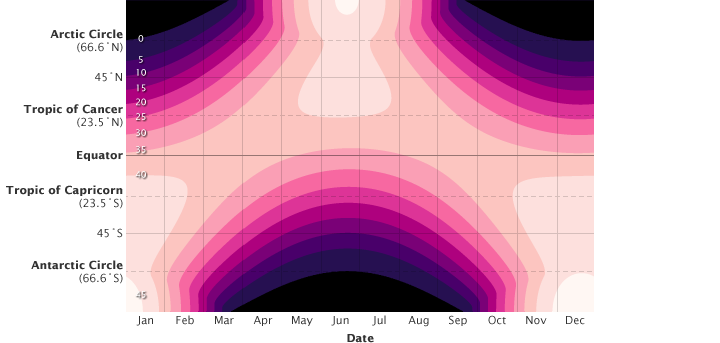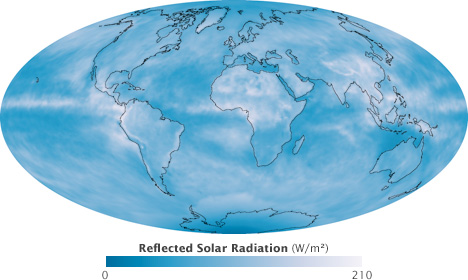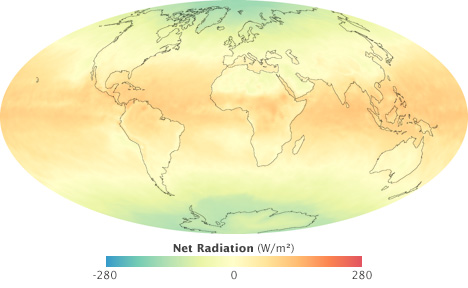

Three hundred forty watts per square meter of incoming solar power is a global average; solar illumination varies in space and time. The annual amount of incoming solar energy varies considerably from tropical latitudes to polar latitudes (described on page 2). At middle and high latitudes, it also varies considerably from season to season.

The peak energy received at different latitudes changes throughout the year. This graph shows how the solar energy received at local noon each day of the year changes with latitude. At the equator (gray line), the peak energy changes very little throughout the year. At high northern (blue lines) and southern (green) latitudes, the seasonal change is extreme. (NASA illustration by Robert Simmon.)
If the Earth’s axis of rotation were vertical with respect to the path of its orbit around the Sun, the size of the heating imbalance between equator and the poles would be the same year round, and the seasons we experience would not occur. Instead Earth’s axis is tilted off vertical by about 23 degrees. As the Earth orbits the Sun, the tilt causes one hemisphere and then the other to receive more direct sunlight and to have longer days.

The total energy received each day at the top of the atmosphere depends on latitude. The highest daily amounts of incoming energy (pale pink) occur at high latitudes in summer, when days are long, rather than at the equator. In winter, some polar latitudes receive no light at all (black). The Southern Hemisphere receives more energy during December (southern summer) than the Northern Hemisphere does in June (northern summer) because Earth’s orbit is not a perfect circle and Earth is slightly closer to the Sun during that part of its orbit. Total energy received ranges from 0 (during polar winter) to about 50 (during polar summer) megajoules per square meter per day.
In the “summer hemisphere,” the combination of more direct sunlight and longer days means the pole can receive more incoming sunlight than the tropics, but in the winter hemisphere, it gets none. Even though illumination increases at the poles in the summer, bright white snow and sea ice reflect a significant portion of the incoming light, reducing the potential solar heating.

The amount of sunlight the Earth absorbs depends on the reflectivness of the atmosphere and the ground surface. This satellite map shows the amount of solar radiation (watts per square meter) reflected during September 2008. Along the equator, clouds reflected a large proportion of sunlight, while the pale sands of the Sahara caused the high reflectivness in North Africa. Neither pole is receiving much incoming sunlight at this time of year, so they reflect little energy even though both are ice-covered. (NASA map by Robert Simmon, based on CERES data.)
The differences in reflectivness (albedo) and solar illumination at different latitudes lead to net heating imbalances throughout the Earth system. At any place on Earth, the net heating is the difference between the amount of incoming sunlight and the amount heat radiated by the Earth back to space (for more on this energy exchange see Page 4). In the tropics there is a net energy surplus because the amount of sunlight absorbed is larger than the amount of heat radiated. In the polar regions, however, there is an annual energy deficit because the amount of heat radiated to space is larger than the amount of absorbed sunlight.

This map of net radiation (incoming sunlight minus reflected light and outgoing heat) shows global energy imbalances in September 2008, the month of an equinox. Areas around the equator absorbed about 200 watts per square meter more on average (orange and red) than they reflected or radiated. Areas near the poles reflected and/or radiated about 200 more watts per square meter (green and blue) than they absorbed. Mid-latitudes were roughly in balance. (NASA map by Robert Simmon, based on CERES data.)
The net heating imbalance between the equator and poles drives an atmospheric and oceanic circulation that climate scientists describe as a “heat engine.” (In our everyday experience, we associate the word engine with automobiles, but to a scientist, an engine is any device or system that converts energy into motion.) The climate is an engine that uses heat energy to keep the atmosphere and ocean moving. Evaporation, convection, rainfall, winds, and ocean currents are all part of the Earth’s heat engine.